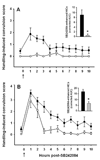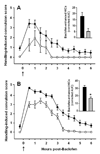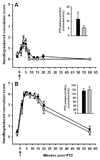5-HT2C and GABAB receptors influence handling-induced convulsion severity in chromosome 4 congenic and DBA/2J background strain mice
- PMID: 18262506
- PMCID: PMC2322873
- DOI: 10.1016/j.brainres.2008.01.024
5-HT2C and GABAB receptors influence handling-induced convulsion severity in chromosome 4 congenic and DBA/2J background strain mice
Abstract
Progress towards elucidating the underlying genetic variation for susceptibility to complex central nervous system (CNS) hyperexcitability states has just begun. Genetic mapping analyses suggest that a gene(s) on mid-chromosome 4 has pleiotropic effects on multiple CNS hyperexcitability states in mice, including alcohol and barbiturate withdrawal and convulsions elicited by chemical and audiogenic stimuli. We recently identified Mpdz within this chromosomal region as a gene that influences alcohol and barbiturate withdrawal convulsions. Mpdz encodes the multi-PDZ domain protein (MPDZ). Currently, there is limited information available about the mechanism by which MPDZ influences drug withdrawal and/or other CNS hyperexcitability states, but may involve its interaction with 5-HT2C and/or GABAB receptors. One of the most useful tools we have developed thus far is a congenic strain that possesses a segment of chromosome 4 from the C57BL/6J (donor) mouse strain superimposed on a genetic background that is >99% from the DBA/2J strain. The introduced segment spans the Mpdz gene. Here, we demonstrate that handling-induced convulsions are less severe in congenic vs. background strain mice in response to either a 5-HT2C receptor antagonist (SB242084) or a GABAB receptor agonist (baclofen), but not a GABAA receptor channel blocker (pentylenetetrazol). These data suggest that allelic variation in Mpdz, or a linked gene, influences SB242084- and baclofen-enhanced convulsions. Our results are consistent with the hypothesis that Mpdz's effects on CNS hyperexcitability, including alcohol and barbiturate withdrawal, involve MPDZ interaction with 5-HT2C and/or GABAB receptors. However, additional genes reside within the congenic interval and may also influence CNS hyperexcitability.
Figures



Similar articles
-
Mpdz expression in the caudolateral substantia nigra pars reticulata is crucially involved in alcohol withdrawal.Genes Brain Behav. 2014 Nov;13(8):769-76. doi: 10.1111/gbb.12171. Epub 2014 Sep 17. Genes Brain Behav. 2014. PMID: 25109596 Free PMC article.
-
Congenic mapping of alcohol and pentobarbital withdrawal liability loci to a <1 centimorgan interval of murine chromosome 4: identification of Mpdz as a candidate gene.J Neurosci. 2002 May 1;22(9):3730-8. doi: 10.1523/JNEUROSCI.22-09-03730.2002. J Neurosci. 2002. PMID: 11978849 Free PMC article.
-
Potential pleiotropic effects of Mpdz on vulnerability to seizures.Genes Brain Behav. 2004 Feb;3(1):8-19. doi: 10.1111/j.1601-183x.2004.00035.x. Genes Brain Behav. 2004. PMID: 14960011
-
Use of recombinant inbred strains for studying genetic determinants of responses to alcohol.Alcohol Alcohol Suppl. 1994;2:67-71. Alcohol Alcohol Suppl. 1994. PMID: 8974318 Review.
-
Epilepsy and obesity in serotonin 5-HT2C receptor mutant mice.Ann N Y Acad Sci. 1998 Dec 15;861:74-8. doi: 10.1111/j.1749-6632.1998.tb10175.x. Ann N Y Acad Sci. 1998. PMID: 9928241 Review.
Cited by
-
Ethosuximide reduces electrographical and behavioral correlates of alcohol withdrawal seizure in DBA/2J mice.Alcohol. 2014 Aug;48(5):445-53. doi: 10.1016/j.alcohol.2014.01.010. Epub 2014 May 4. Alcohol. 2014. PMID: 24933286 Free PMC article.
-
Genetic studies of alcohol dependence in the context of the addiction cycle.Neuropharmacology. 2017 Aug 1;122:3-21. doi: 10.1016/j.neuropharm.2017.01.017. Epub 2017 Jan 22. Neuropharmacology. 2017. PMID: 28118990 Free PMC article. Review.
-
Mpdz expression in the caudolateral substantia nigra pars reticulata is crucially involved in alcohol withdrawal.Genes Brain Behav. 2014 Nov;13(8):769-76. doi: 10.1111/gbb.12171. Epub 2014 Sep 17. Genes Brain Behav. 2014. PMID: 25109596 Free PMC article.
-
Involvement of the limbic basal ganglia in ethanol withdrawal convulsivity in mice is influenced by a chromosome 4 locus.J Neurosci. 2008 Sep 24;28(39):9840-9. doi: 10.1523/JNEUROSCI.1713-08.2008. J Neurosci. 2008. PMID: 18815268 Free PMC article.
-
Discovering genes involved in alcohol dependence and other alcohol responses: role of animal models.Alcohol Res. 2012;34(3):367-74. Alcohol Res. 2012. PMID: 23134054 Free PMC article.
References
-
- Amabeoku G, Chikuni O. Effects of some GABAergic agents on quinine-induced seizures in mice. Experientia. 1992;48:659–662. - PubMed
-
- Annegers JF, Rocca WA, Hauser WA. Causes of epilepsy: contributions of the Rouchester epidemiology project. Mayo. Clin. Proc. 1996;71:570–575. - PubMed
-
- Balasubramanian S, Fam SR, Hall RA. GABAB receptor association with the PDZ scaffold Mupp1 alters receptor stability and function. J. Biol. Chem. 2007;282:4162–4171. - PubMed
-
- Bergeson SE, Warren RK, Crabbe JC, Metten P, Erwin VG, Belknap JK. Chromosomal loci influencing chronic alcohol withdrawal severity. Mamm. Genome. 2003;14:454–463. - PubMed
Publication types
MeSH terms
Substances
Grants and funding
- AA011114/AA/NIAAA NIH HHS/United States
- R01 AA011114/AA/NIAAA NIH HHS/United States
- F31 AA013685/AA/NIAAA NIH HHS/United States
- R01 DA005228/DA/NIDA NIH HHS/United States
- P50 AA010760/AA/NIAAA NIH HHS/United States
- R29 AA011114/AA/NIAAA NIH HHS/United States
- AA13685/AA/NIAAA NIH HHS/United States
- F31 AA017031/AA/NIAAA NIH HHS/United States
- AA10760/AA/NIAAA NIH HHS/United States
- T32 AA007468/AA/NIAAA NIH HHS/United States
- AA07468/AA/NIAAA NIH HHS/United States
- DA05228/DA/NIDA NIH HHS/United States
- P60 AA010760/AA/NIAAA NIH HHS/United States
LinkOut - more resources
Full Text Sources
Medical
Molecular Biology Databases

